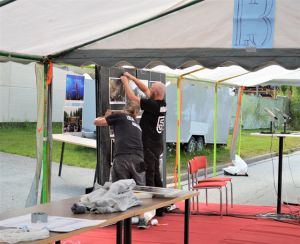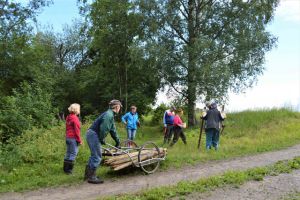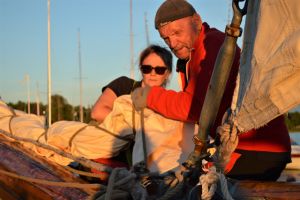Talkoot work tradition
| Talkoot work tradition | ||||
|---|---|---|---|---|
|
Practitioners and people who know the tradition well
"Talkoot" is a centuries-old form of voluntary work in Finland and an important part of Finnish cultural heritage. Talkoot work is unpaid labor done as a way to help the community or individuals. Talkoot work could be, for example, renovating a community hall with the help of the community, participating in a friend's yard work session, or serving as a kiosk vendor at a sports event.

People of various ages and backgrounds engage in the tradition of talkoot, although participants rarely think of it as practicing a tradition. Organizers and participants of talkoot have goals beyond the talkoot themselves, aiming to achieve a desired outcome, which could be an event, a tidied-up yard, move into a new home, or, prehaps, repairing a roof.
Talkoot are organized by various associations, organizations, and individuals. The organizers could be, for example, sports clubs, neighborhoods, or local heritage associations. In Finland, numerous sports, music, and cultural events are organized annually with the help of volunteer labor, and also various other projects are carried out through talkoot efforts.
The traditions and terminology related to talkoot may vary from one region to another in Finland. For example, in Ostrobothnia and the municipality of Karvia in Northern Satakunta, the term "kökkä" is used to refer to talkoot. Throughout history, village communities in different parts of Finland have been important organizers of talkoot, and they continue to play this role today. Talkoot are used to organize events and hobby activities that are often essential for the vitality of small towns. In different regions, talkoot activities help maintain and preserve local cultural heritage, such as local heritage museums. As an example, in 2020, Hankasalmi Local Heritage Society was selected as the Heritage Association of the Year, as they maintain an open-air museum almost entirely with volunteer efforts, and talkoot events are held almost daily.
Practising of the tradition

Talkoille on tyypillistä Talkoot are characterized by the gathering of a specific community, working together, and providing refreshments to the participants. In Finland, talkoot are organized throughout the year, but the main seasons for talkoot are spring, summer, and autumn. For instance, many housing cooperatives organize traditional spring clean-up talkoot in the spring. The goal of talkoot is to achieve a specific outcome through collective effort, such as organizing an event or repairing a building.
Talkoot typically begin with inviting and gathering the volunteers. After the volunteers have assembled, the next step is usually to distribute the talkoot tasks. Talkoot tasks can also be assigned in advance, and roles may change during the course of the talkoot. The distribution of tasks is often based on the participants' own skills. The tasks themselves depend on the nature of the talkoot. In traditional yard work talkoot, tasks may include raking leaves or mowing the lawn. When organizing an event, various roles can include being a guide for artists or working as a ticket vendor. Talkoot roles often include a supervisor or a coordinator responsible for organizing the work. Another traditional role is that of a provider responsible for serving refreshments. In the past, women were often in charge of serving, while men handled physical labor, but these gender roles are not as strictly defined today. Successful talkoot involve assigning tasks that suit a participant's abilities and skills while also providing an opportunity to learn something new.
An essential part of talkoot is refreshments. It is a way to reward the volunteers and express gratitude for their work. Refreshments also ensure that the volunteers have the energy to carry out their tasks. Serving refreshments brings the talkoot participants together and fosters social interaction among them. Offering refreshments and reciprocity have been crucial aspects of talkoot for many centuries. For example, in Nordic countries, serving food and drink played a significant role in events like "sontatalkoot" (manure spreading talkoot) dating back to the 16th century. Sontatalkoot were such important events that there was even a celebration of eve of talkoo day. Preparations for refreshments would begin several days in advance, involving baking, cooking, cleaning, and brewing beer. Food served during talkoot was often festive, and sometimes a special talkoo ox would be slaughtered for the occasion. Coffee, "vaarinkalja" (a traditional Finnish beverage), and "sahti" (Finnish farmhouse ale) were typically served during work breaks.
Today, traditional offerings at talkoot often include sausages, sandwiches, and various soups. Additionally, coffee and other beverages are almost always available. Talkoot refreshments can also vary by region. For instance, in Northern Satakunta, traditional drink served at talkoot is sahti.

An important part of talkoot is thanking and rewarding the volunteers. Ways to express gratitude to talkoot participants may include refreshments, a post-talkoot sauna, words of appreciation, or organizing a special event for the volunteers after the work is completed. Monetary compensation is not part of the talkoot reward system. A post-talkoot event is often referred to as "loppukaronkka" (end-of-talkoot party). This party is a significant aspect of the sense of community among talkoot participants, as it brings them together after the talkoot, sometimes even long after the actual work is done. During a loppukaronkka, talkoot experiences can be shared, and plans for future talkoot may be discussed.
The background and history of the tradition
Talkoot play a significant role in creating and maintaining a sense of community. In challenging times, talkoot have been used to sustain society and instill hope for a better future. Additionally, talkoot serve as a model for children and young people, teaching them about the right work ethic and the importance of helping others.
The tradition of talkoot has deep roots in Finnish society, and talkoot have been carried out since ancient times. The word "talkoot" itself dates back at least 2000 years, as similar
words can be found in the Latvian, Lithuanian, and German languages. These language-speaking communities lived as neighbors to the Finnish tribes around the time of the beginning of The Common Era. However, the origins of talkoot can be traced even further back in history. The emergence of talkoot can be linked to the beginning of agriculture, as settled living became necessary for farming. With settled living came the formation of small communities that collaborated on building and farming tasks.
Starting from the Middle Ages, in the arable regions of Western Finland and Sweden, fields were often collectively enclosed, and fields were divided into two or three common plots for the entire village. All participants had to complete the hay harvest before allowing the cattle to graze on the fields. This practice fostered cooperation among neighbors and laid the foundation for neighborly assistance and talkoot work. Assistance among residents in a village was an essential structural element. The primary aim was not just to help an individual farmer but to work for the benefit of the entire village community. Olaus Magnus's "Pohjoisten kansojen historia" (History of the Northern Peoples) from 1555 mentions talkoot work in the Nordic countries during the 16th century. Tasks such as manure hauling, hay harvesting, and grain harvesting were done through talkoot work. As a reward for hay harvesting and grain reaping, evening feasts were organized. Refreshments and libations, such as alcohol, were believed to attract people to participate in talkoot.
Talkoot work has been a crucial support system in agricultural communities. There was a lot of work to be done, but money was scarce. Talkoot labor was used to accomplish labor-intensive agricultural tasks. These tasks included construction work, flax preparation, spinning, hay and grain harvesting, and timber transport. Moreover, talkoot were used to help those in need or facing hardships. After World War II, talkoot became a grassroots movement in Finland, as there was a significant need for assistance. Talkoot could also compensate for the labor shortage caused by working-age individuals being enlisted for defense tasks. Young and old, men and women, rural and urban residents all participated in talkoot. Simultaneously, talkoot work was a way to assist those facing difficulties due to the war, including immigrant and frontline soldier families, war veterans, war widows, and orphans.
Talkoot also served as an excellent opportunity to meet new people or find a spouse. After the work was done, it was customary to organize refreshments, talkoot dances, or group games. These events attracted people and also acted as social occasions for the town people to celebrate and interact. People often dressed better than usual when attending talkoot, as talkoot and related events provided a sense of belonging for the town people. In addition to fostering a sense of community, talkoot taught different generations to value one another and the importance of collective effort.
With advancements in agricultural technology, the significance of talkoot changed, and its appreciation declined. Talkoot became more about selfless assistance intended for the weakest members of the community. Nevertheless, talkoot work continued to hold the village community together and functioning.
The transmission of the tradition
Different communities and individuals carry on the tradition by organizing talkoot. Simultaneously, the need for assistance and the desire to accomplish various tasks are
reasons for continuing the tradition of talkoot. The societal situation has also influenced the tradition's continuity.
In 1929, under the leadership of E.A. Virtanen, the Sanakirjasäätiö (Dictionary Foundation) conducted a survey on talkoot activities throughout Finland. The survey was recorded to be used by researchers. During World War II, talkoot activities were developed through the establishment of various associations. After World War II, talkoot work became an important form of post-war reconstruction, instilling hope for a better future and a sense of collective strength.
Suomen Talkoot ry (The Finnish Talkoot Association) was founded in the autumn of 1940 after the Winter War, initiated by the Academic Karelia Society. The association aimed to promote knowledge and understanding of talkoot traditions through educational efforts. Following a suggestion by Kustaa Vilkuna, Suomen Talkoot Ry gathered short articles from young folklorists about various regional talkoot practices. Once these articles were completed, they were made freely available to the Finnish press. Additionally, Suomen Talkoot Ry served as an organizer for various talkoot activities. The association's organized talkoot supported and assisted war widows and orphans, war veterans, those in difficulties, Karelian evacuees, as well as low-income and large families.
In 1941, the Nuorten Talkoot –työliike (Youth Talkoot Movement) was established to encourage young people to engage in suitable work. The movement aimed to strengthen the appreciation of work, neighborly love, young people's morals, and the virtue of thrift. In 1942, Suurtalkoot Ry was founded, tasked with directing and planning extensive and diverse talkoot activities across the country and involving citizens from different social classes. The goal was to compensate for lost work hours and labor during the war and to provide assistance to those in need. In 1942, Finland initiated nationwide talkoot campaing with "aseveljien puutalkoot" (brothers-in-arms wood talkoot). Additionally, talkoot activities included planting work, garden and field work, as well as late summer hay and grain harvesting. In rural areas, repairs of clothing and shoes were carried out in repair talkoot. In the autumn of 1942, Finland faced a severe firewood shortage, leading to the organization of "halkotalkoot" (firewood talkoot) as a solution. A Finnish sayin one motti (cubic meter of firewood) for one man became famous, and the number of "mottis" even led to a national competition between municipalities.

In recent years, the talkoot tradition has been carried forward through various campaigns. In 2011, Finland organized the Suomi puhtaaksi – päivässä! (Finland Cleaned Up in a Day!) environmental campaign, aiming to hold a nationwide cleanup talkoot. The goal was to clean up nature, and 172 municipalities and approximately 295,000 Finns participated. The event was held again in 2012 under the name "Talkoillaan – Suomi Puhtaaksi!" (Let's Talkoot and Clean Up Finland!). Finland has also established an official talkoot day. The first talkoot day took place on May 17, 2014, and the most recent one was organized in 2016.
Today, communities and organizations continue to carry on the tradition by organizing various activities, such as events. Additionally, the tradition is passed on from parents to children. Annual events gather the same talkoolaiset (participants) year after year. For these participants, talkoot may be such an important annual event that they schedule their summer vacations around it. Examples of such events include KarmaRock in Harjavalta and the theater festival "Lainsuojattomat" in Pori. In the past year, it has become evident
that the traditional purpose of talkoot – providing communal assistance to the less fortunate – is still very much alive. Due to the conflict in Ukraine, numerous individuals and organizations have organized talkoot to collect material and immaterial aid for Ukrainians.
The future of the tradition
There have been changes in the talkoot culture over the past decade, and the popularity of volunteer work has fluctuated in recent decades. In the activities of nonprofit organizations, talkoot has decreased, and concurrently, local heritage activities have decreased. The future of talkoot depends on active communities and the ability to engage younger generations in these activities. Many feel that the talkoot tradition has declined.
However, talkoot events are still being organized actively, but their goals and forms have evolved. Traditional rural talkoot have decreased in part due to technological
advancements, and rural-to-urban migration has reduced populations in smaller villages. The aging of talkoot participants and the difficulty of finding successors can be challenging. Consequently, new participants for talkoot may not be readily available in smaller communities. It is also considered a problem that young adults often lack the time and resources for volunteer work. There is a risk that, along with the talkoot tradition, other aspects of cultural heritage may disappear.
On the other hand, talkoot continue to create new cultural heritage. In many places, the talkoot tradition is thriving, even in smaller communities. For example, cultural activities or sports club activities often rely primarily on talkoot work. This reflects the significance of talkoot: when a community needs something—whether it's a cultural event, a rock festival, theater, or recreational opportunities for the younger generation—that society doesn't provide, people create it themselves. Talkoot activities remain a natural part of communities' toolkit for producing desired outcomes, and the talkoot tradition is deeply ingrained in people's consciousness.
The strength of the community and the desire to contribute to it are the reasons why the talkoot tradition persists. Throughout history, the talkoot tradition has evolved in response to society's needs. In the future, the talkoot tradition may take on new forms that reflect the times and societal norms.
The community/communities behind this submission
Finnish Local Heritage Federation
Rural Women's Advisory Organization
Bibliography and links to external sources of information
Bibliography:
Leiponen, Kauko 1987: Kansa talkoissa. Gummerus Oy, Jyväskylä.
Pukkila, Hanna 2007: Tehdään yhdessä – Opas onnistuneisiin talkoisiin. Helmi Kustannus, Helsinki.
Vilkuna, Kustaa 1983: Työ ja ilonpito. Kustannusosakeyhtiö Otava, Keuruu.
Online sources:
Siltanen, Mari 10.5.2020 : Roskat maisemassa ovat roskia mielessä. Yle.fi.
Talkoopäivä 14.5.2016. Talkoot.fi
Talkoopäivän julkaisutilaisuus. Sitra, 11.02.2014.
Talkoot – perinteen tallentaminen, talkoohengen etsiminen ja hyvien talkoiden reseptin laatiminen -hankeraportti, Satakunnan Museo 19.5.2023
